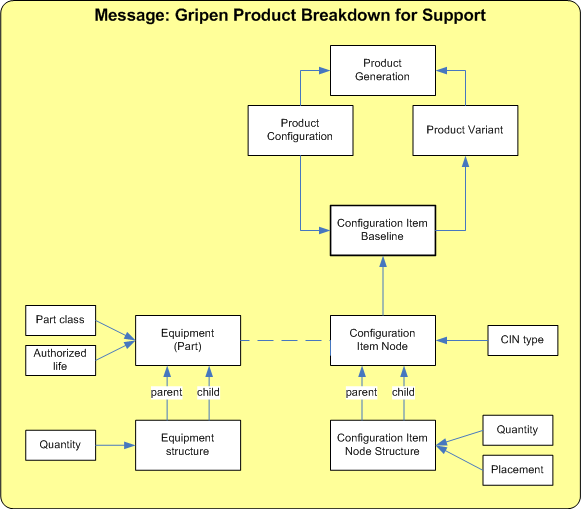
| Business DEX (NOLITO001):— Gripen_product_breakdown | Date: 2008/12/07 15:20:14 Revision: 1.21 |
This section provides a high level overview of the business information that can be represented by this Business DEX. A more detailed overview of the information is described in Gripen_product_breakdown Business Information Requirements , and a detailed definition of how the information is represented using ISO 10303-239 PLCS is provided inGripen_product_breakdown ISO 10303-239 Representation.
The information constituting the Gripen Breakdown Structure for Support that can be exchanged using this Business DEX is summarized in Figure 4 below.

The Gripen Product Generation is identified as e.g. "AC39E", which means Aircraft 39 (the generic Gripen product) and generation "E", which implies the third product generation for the two-seat aircraft variant.
The Gripen Product Variant is expressed using a coded string, for example "AC39ENoK1", identifying the Product Generation "AC39E", followed by "No" which signifies the customer (Norway), and "K1", which is the identifier of the functional level (major functionality of the aircraft).
The Gripen Product Configuration is internally at Saab called "seriestatus", and is a combination of the status of the software and the hardware, e.g. "8830.04-44.0". This unambiguously identifies all Configuration Item Nodes and their realizations that are valid for that specific Product Configuration. So, a specific Product Configuration is unambiguously identified down to the level of equipment valid in the configuration, and the list of valid equipment for a Product Configuration at a certain point in time is called the Configuration Item Baseline.
The Configuration Item Baseline is a list of valid equipment for a Product Configuration at a certain point in time, organized in a breakdown structure of the product. The breakdown itself is identified as the concatenation of the Product Variant string and "CIN_breakdown" (for Configuration Item Node Breakdown), e.g. "AC39ENoK1_CIN_breakdown", and is classified as a "CIN_breakdown", which is really a mix of a functional and system breakdown..
Each exchange of Gripen Product Breakdown Structure data represents one or more Baselines of the Product Configuration. There may be several baselines of one Product Configuration over time. Therefore, the Breakdown Structure can have revisions, and each revision represents a specific baseline.
A baseline (Breakdown revision) is identified by concatenating the Product Configuration identifier with a revision number corresponding to the baseline, e.g. "8830.04-44.0;1". Thereby, a baseline is a snap shot in time of a specific Product Variant with a specific Product Configuration (seriestatus).
The Gripen Configuration Item Node Structure is the actual breakdown structure of the Configuration Items. It consists of a top node representing the product variant, which is then broken down in Material groups (e.g. Environmental control system MG36, and the Fuel system MG37) and their Subsystems (e.g. "" and ""), and the leaf nodes in the structure are the concept of Equipment, or the "Maintenance Objects" as they are called in the Saab system ILS-DB.

This Gripen Configuration Item Node structure is mainly stored in the Saab system Teamcenter PDM, but there is an overlap (and possible discrepancy) at the nodes in the structure, i.e. the number of nodes below a subsystem in Teamcenter PDM may not be identical with the number of Maintenance Objects in ILS-DB. This typically happens when an equipment is maintained differently depending on its location while the design and production departments do not identify any differences. Discrepancies should be resolved in favour of ILS-DB.
Each Configuration Item Node, representing either a material group, a subsystem, or an Equipment or similar maintenance object, has a name (e.g. "Fuel system") and ID (e.g. "JS-CI-00057"), and is classified as one of the following: Product_variant, Subsystem, Hardware_item or Software_item.
The top node of the Configuration Item Node Structure is named after the Product Variant (e.g. "AC39ENoK1"),
Each leaf Configuration Item Node is realized by one or more Equipments, i.e. a Part (in most cases bought from a supplier). An Equipment is named and has a Saab ID, e.g. "9307009-601". It is also classified as being either an assembly, a component or a standard component.
Each Equipment may have a property called "Authorized life", used to indicate the maximum use of the equipment, before which the equipment need maintenance. The Authorized life property may contain multiple values, e.g. "200 flight hours" plus "6 calendar months", whichever occurs first.
An equipment may have parts (units) that can be replaced in a maintenance activity, e.g. data cards or similar spare parts. Those constituent parts may be represented as a list, or in a structure of several levels.
© Saab AB 2010 — All rights reserved